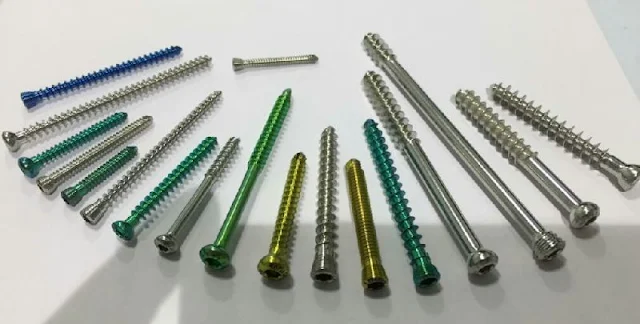Ad Code
Translate
Smart strategies for trading on crypto exchanges
October 20, 2025
Five Do’s For a Healthy Turnover That Bolsters Talent-Retention
October 20, 2025
Discover Honeybee Pharmacy (2025 Guide Important Consumer Tips)
October 14, 2025
What is Ozempic (semaglutide)? (Updated in 2025)
January 30, 2025
How To Find Suitable Properties In Cyprus?
October 20, 2025
Posture Bra: Improving Back Support and Comfort
October 20, 2025
10 Effective Strategies to Improve Domain Authority of Your Website
October 20, 2025
Types of Bone Screws
Khabza Mkhize
March 05, 2024
The bone screw is used as an implant in Orthopaedics to hold two or more objects together and to have the ‘LAG’ effect, i.e., compressing two surfaces. In the AO system, there are the two most common types of bone screws based on the type of fracture and the consistency of tissues of bones: the cortex and the cancellous bone screw.
- Cortex screw: This type of orthopedic bone screw is used explicitly for diaphyseal bone. These screws have smaller threads and a lower pitch. A cortex screw can be self-tapping and non-self-tapping.
- Cancellous screws: A cancellous screw is used as a placement screw to fix a bone plate in the metaphyseal and epiphyseal region. These screws have a deeper thread, a larger pitch, and a larger outer diameter as compared to cortex screws.
- Schanz screws: These screws are used in both open and closed fracture fixation. The latest design of the Schanz screw has a less deep thread to provide less sharp edges. These screws have a larger core diameter. It provides better strength against the forces that act perpendicular to the long axis of the screw, and if used accurately, Its self-cutting thread provides a good purchase.
Locked screws
These screws are designed recently for diaphyseal application of internal fixators (PC-Fix and LISS) and may be self-drilling, self-cutting, and unicortical, and the screw head locks in the plate hole. They are “locked screws” because their inclination with the “plate” body is fixed. These screws as a fixed angle device, which is helpful in metaphyseal fractures if a minimally invasive technique is used.
Herbert bone screws
Herbert bone screw is a cannulated screw with a changeable pitch, as there is a thread at each end of the screw. This is a headless compression screw. This screw is used for interfragmentary compression with the help of its variable pitch. This screw has been mainly used by surgeons in scaphoid fractures, Carpal bones, and other minor joints fusion in the wrist and hand. Find out more about this type of screw by looking online for Hand Surgeons near me.
Shaft screws
The working of a lag screw is better understood by examining a screw which has a short thread and a shaft, the diameter of the core or of the thread. The smooth shaft mainly has a diameter corresponding to the inner core of the thread. When it is applied to a tubular diaphyseal bone, the thread anchors within the far cortex and in the near cortex. The shaft produces no axial force, but the head provides a buttress against axial tension.
Mode of application of a fully threaded lag screw
If a thread is kept from engaging within the cortex near the screw head, a fully threaded screw can be applied as a lag screw. This can be done by drilling a clearance or gliding hole of a diameter slightly larger than the outer diameter of the screw thread within the near cortex. When an inclined screw thread produces axial force, it tends to shift the screw head along the bone surface in the direction of the fracture. In this condition, the use of a lag screw with a shaft corresponding to the outer diameter of the thread, i.e., shaft screws, can be recommended. Or else, the screw thread can engage within the gliding hole, and there may be loss of efficiency. Mainly, Shaft screws or fully threaded screws are used in the diaphyseal bone as partly threaded cancellous bone screws are not easy to remove after healing.
Screw-tightening and torque-limiting screwdrivers
Because the screws produce a high amount of axial force, the screws must not be tightened to their highest limit. In this way, a surgeon should tighten the screws to the degree optimal and compatible with screw and/or bone strength. Then, one can achieve 86% of the thread-stripping torque on average.
Moreover, when the holding force of a screw is entirely used by static preload, there is limited holding force left contrary to additional functional load. The new self-locking screws of the PC-Fix and the LISS lock upon tightening in the plate hole, thus keeping the screw and the bone safe. For these new techniques, a torque-limiting screwdriver proves helpful to prevent the screw heads from getting jammed in the conical holes, whether it is threaded or not. However, torque-limiting screwdrivers prove less valuable when the bone density and thickness vary from region to region.
Featured Post
DL Mining Launches Ethereum Contract Participation Service, Helping Users Earn $2K Stable Daily Returns
Zizo Gala-Mkhize-
October 20, 2025
Soapie Teasers
Sister Sites
Most Popular
List of 6,000+ Dofollow Commentluv Blogs FREE (Updated 2025)
January 16, 2025
Five Do’s For a Healthy Turnover That Bolsters Talent-Retention
October 20, 2025
How To Choose The Right Place For A Winter Campsite
March 06, 2023
Popular posts
List of 6,000+ Dofollow Commentluv Blogs FREE (Updated 2025)
January 16, 2025
Five Do’s For a Healthy Turnover That Bolsters Talent-Retention
October 20, 2025
How To Choose The Right Place For A Winter Campsite
March 06, 2023
Footer Menu Widget
Created By Blogspot Theme | Distributed By Gooyaabi Templates


Social Plugin